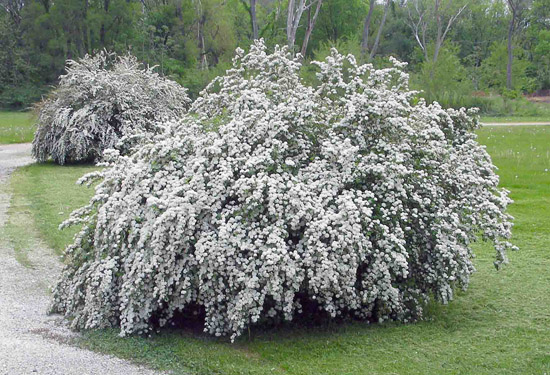Issue 3, May 19, 2014
Bridalwreath Spirea and Insect Management
Bridal wreath spirea, or Vanhoutte spirea (Spiraea x vanhouttei), is blooming in throughout the state. This is a major phenology plant in Don Orton's book Coincide. With phenology, stages of plant development (usually bloom time) are used to predict stages in pest development. This method is more accurate than using calendar dates because the plant is exposed to the same climatic conditions as the insect. Thus, "early" and "late" springs associated with unusually high or low temperatures, respectively, cause similar responses in both plant and insect.

Vanhoutte spirea.
Don Orton revised Coincide in 2007 to include phenology information on diseases as well as insects. It continues to be published by Labor of Love Conservatory, 723 Dawes Avenue, Wheaton, IL 60187, (630)668-8597, dennyjam@aol.com. Although occasionally sold in gift stores in locations such as the Morton Arboretum, Chicago Botanic Garden, and Missouri Botanic Garden, it is normally not seen in bookstores. It is probably easiest to obtain directly from the publisher.
Phenology helps predict when pest stages susceptible to control are likely to be present, but it is not a spray guide. When a phenological event predicts that a pest is susceptible to control, one needs to scout to verify that the pest is present and in a susceptible stage before using a control measure. We include phenology information from Coincide in our University of Illinois Extension pest management recommendations published in the Illinois Commercial Landscape and Turfgrass Pest Management Handbook. Following are the most common pests that are in susceptible treatment stages during vanhoutte spirea bloom.
Full bloom: Birch leafminer young larvae; elm leaf beetle young larvae; European pine sawfly feeding larvae; gypsy moth feeding larvae; pine needle scale crawlers (first generation), black turfgrass ataenius (first generation).
Full to late bloom: Lilac (ash) borer newly hatched larvae; oystershell scale (brown) crawlers.
Finishing bloom: Bronze birch borer newly hatched larvae.
Most blossoms brown, still a few white: Flat-headed appletree borer larval hatch; peach tree borer newly hatched larvae; viburnum borer newly hatched larvae.
Bloom finished: Oystershell scale (gray) crawlers. (Phil Nixon)
Author:
Phil Nixon